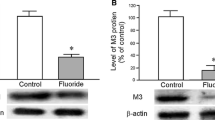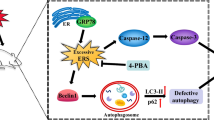Abstract
The objective of this study is to investigate the neurotoxicity of drinking water fluorosis on rat hippocampus. Just weaning male Sprague–Dawley rats were randomly divided into four groups and given 15, 30, and 60 mg/L NaF solution and distilled water, respectively, for 9 months. The fluidity of brain synaptic membrane and expression level of postsynaptic density 95 (PSD-95) were tested. Results showed that the fluidity of brain synaptic membrane decreased gradually with increasing of fluoride concentration, and it was significantly decreased (P < 0.05) in moderate-fluoride group compared with control group, and expression level of PSD-95 was significantly decreased (P < 0.01) in moderate-fluoride group when compared with that of control group. These results indicate that decrease of synaptic membrane fluidity and PSD-95 expression level may be the molecular basis of central nervous system damage caused by fluoride intoxication; PSD-95 in CA3 region of hippocampus is probably a target molecule for fluoride.


Similar content being viewed by others
References
Choubisa SL, Choubisa L, Choubisa D (2009) Osteo-dental fluorosis in relation to nutritional status, living habits, and occupation in rural tribal areas of rajasthan, India. Fluoride 42:210–215
He Y, Niu RY, Wang JM et al (2008) Effects of protein versus calcium supplementation on bone metabolism and development in fluoride-exposed offspring rats fed protein- and calcium-deficient diets. Fluoride 41:192–198
Trivedi MH, Verma RJ, Chinoy NJ (2009) Mitigation of sodium fluoride induced toxicity in mice brain by black tea infusion. Fluoride 42:29–33
Ranjan R, Swarup D, Patra RC (2009) Oxidative stress indices in erythrocytes, liver, and kidneys of fluoride-exposed rabbits. Fluoride 42:88–93
Shila S, Kokilavani V, Subathra M et al (2005) Brain regional responses in antioxidant system to alpha-lipoic acid in arsenic intoxicated rat. Toxicology 210:25–36
Gao Q, Liu YJ, Guan ZZ (2008) Oxidative stress might be a mechanism connected with the decreased a7 nicotinic receptor influenced by high-concentration of fluoride in SH-SY5Y neuroblastoma cells. Toxicol In Vitro 22:837–843
Bhatnagar M, Rao P, Sushma J et al (2002) Neurotoxicity of fluoride: neu-rodegeneration in hippocampus of female mice. Indian J Exp Biol 40:546–554
Li G, Lu X, Jing L (2000) Hepatocyte and neuron apoptosis induced by chronic fluorosis in rats. Fluoride 33:14–15
Zhang ZZ, Xu XL, Shen XY et al (2008) Effect of fluoride exposure on synaptic structure of brain areas related to learning-memory in mice. Fluoride 41:139–143
Cayabyab FS, Khanna R, Jones OT et al (2000) Suppression of the rat microglia Kv1.3 current by src-family tyrosine kinases and oxygen/glucose deprivation. Neurosci 12:1949–1960
Scheff SW, Price DA, Hicks RR et al (2005) Synaptogenesis in the hippocampal CA1 field following traumatic brain injury. J Neurotrauma 22:719–732
Erik K (1987) Determination of inorganic fluoride in blood with a fluoride ion-selective electrode. Clin Chem 33:253–255
Nagy A, Delgado-Escueta AV (1984) Rapid preparation of synaptosomes from mammalian brain using nontoxic isoosmotic gradient material (Percoll). J Neurochem 43:1114–1123
Hensley K, Carney J, Hall N et al (1994) Electron paramagnetic resonance investigations of free radical-induced alterations in neocortical synaptosomal membrane protein infrastructure. Free Radic Biol Med 17:321–331
Su JJ, Osoegawa M, Matsuoka T et al (2006) Upregulation of vascular growthfactors in multiple sclerosis: correlation with MRI findings. J Neurol Sci 243:21–30
Toper R, Aviram A, Aviram I (1987) Fluoride mediated activation of guinea pig neutrophils. Biochim Biophys Acta 931:262–266
Della Bianca V, Grzeskowiak M, Dusi S et al (1988) Fluoride can activate respiratory burst independently of Ca2+ stimulation of phosphoionsitide turnover, and protein kinase C translocation in primed human neutrophils. Biochem Biophys Res Commun 150:955–964
Guan ZZ, Wang YN, Xiao KQ et al (1998) Influence of chronic fluorosis on membran lipids in rat brain. Neurotoxicol Teratol 20:537–542
Cullis PR, Hope MJ (1985) Physical properties and functional roles of lipids in membranes. In: Vance DE, Vance JE (eds) Biochemistry of lipids and membranes. Benjamin/Cummings, Menlo Park, pp 25–72
Wu A, Ying Z, Gomez Pinilla F (2006) Dietary curcumin counteracts the outcome of traumatic brain injury on oxidative stress, synaptic plasticity, and cognition. Exp Neurol 197:309–317
de la Monte SM, Neely TR, Cannon J et al (2000) Oxidative stress and hypoxia-like injury cause Alzheimer-type molecular abnormalities in central nervous system neurons. Cell Mol Life Sci 57:1471–1481
Matzilevich DA, Rall JM, Moore AN et al (2002) High-density microarray analysis of hippocampal gene expression following experimental brain injury. J Neurosci Res 67:646–663
Yi JH, Hazell AS (2006) Excitotoxic mechanisms and the role of astrocytic glutamate transporters in traumatic brain injury. Neurochem Int 48:394–403
Krapivinsky G, Mochida S, Krapivinsky L et al (2006) The TRPM7 ion channel functions in cholinergic synaptic vesicles and affects transmitter release. Neuron 52:485–496
Lechuga-Sancho AM, Arroba AI, Frago LM et al (2006) Reduction in the number of astrocytes and their projections is associated with increased synaptic protein density in the hypothalamus of poorly controlled diabetic rats. Endocrinology 147:5314–5324
Gascón S, Sobrado M, Roda JM et al (2008) Excitotoxicity and focal cerebral ischemia induce truncation of the NR2A and NR2B subunits of the NMDA receptor and cleavage of the scaffolding protein PSD-95. Mol Psychiatry 13:99–114
Chen P, Gu Z, Liu W et al (2007) Glycogen synthase kinase 3 regulates N-methyl-D-aspartate receptor channel trafficking and function in cortical neurons. Mol Pharmacol 72:40–51
Ehrlich I, Klein M, Rumpel S et al (2007) PSD-95 is required for activity-driven synapse stabilization. Proc Natl Acad Sci USA 104:4176–4181
Tsuriel S, Geva R, Zamorano P et al (2006) Local sharing as a predominant determinant of synaptic matrix molecular dynamics. PLoS Biol 4:e271
Gorczyca D, Ashley J, Speese S et al (2007) Postsynapticmembrane addition depends on the Discs-Large-interacting t-SNARE Gtaxin. J Neurosci 27:1033–1044
Lang SB, Stein V, Bonhoeffer T et al (2007) Endogenous brain-derived neurotrophic factor triggers fast calcium transients at synapses in developing dendrites. J Neurosci 27:1097–1105
Acknowledgements
This research was sponsored by the National Natural Science Foundation of China (Grant No. 30871295) and Natural Science Foundation of Zhejiang Province (Grant No. Y207751).
Author information
Authors and Affiliations
Corresponding author
Rights and permissions
About this article
Cite this article
Zhu, W., Zhang, J. & Zhang, Z. Effects of Fluoride on Synaptic Membrane Fluidity and PSD-95 Expression Level in Rat Hippocampus. Biol Trace Elem Res 139, 197–203 (2011). https://doi.org/10.1007/s12011-010-8654-9
Received:
Accepted:
Published:
Issue Date:
DOI: https://doi.org/10.1007/s12011-010-8654-9




